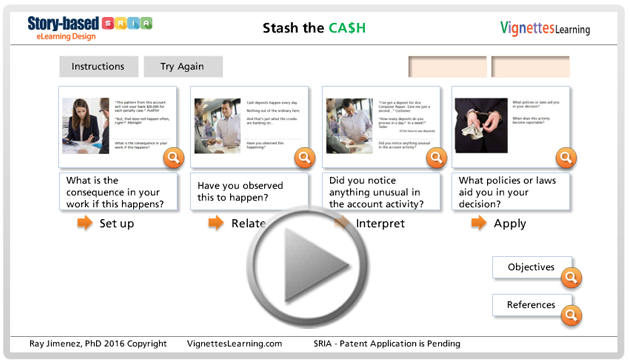Do you want to know how simple it is to apply the step-by-step process for creating a Story-Based Lesson? Fear not. There is actually a logic to the process, even if the outcome can be emotional and provocative.
Play this interactive exercise on “Stash the Cash” – a Fraud Detection Story-Based Design.

There are four steps to the process.
SET UP
| |
The Set Up is a Story-Based Learning Objective; unlike the static and linear learning objectives, we help learners to immediately recognize the value of these new approach to creating objectives and the lessons to be learned. | |||
| |
Getting learners to look forward to the lesson (State of Readiness) and giving them a peek of what lies ahead (objectives, goal-setting) | |||
| |
Show a challenging scene from the story | |||
| |
Ask Story Questions to bring the learners to the why and what would happen (possible consequences). |
RELATE
Learners are now jumping into the water, getting deeply immersed. Here they learn to find their place (Context). As we learned in the previous chapter, the Autobiographical Memory begins to make a connection with the learning.
Story Question Guide:
| |
Use experiential questions “Have you ever sat in one place in the same position for hours on end? How did you feel then?” |
INTERPRET
The learners are now in possession of knowledge which, coupled with their experiences can propel them faster, harder and closer to the Finish Line. Here, we bridge gaps in rapid succession, zip into new evaluations and strengthen connections. Almost there!
This is an example of an “Interpret” question:
| |
Use “what if…?” questions “You’re planning to relax at home and it’s the weekend. What if you were told that you must sit close to your TV with your back hunched and your arms crooked in front of you for 8 hours? |
APPLY
This is it. The home stretch. Just the learner, the road and the finish line somewhere in the distance. Just a few short sprints and voila! Success!
Story Question Guide:
| |
Use questions in the form of scenarios and allow learners to explore different options “You notice your employees work while slumped over their keyboards. This causes lethargy and an overall environment of sluggishness. Later in the day, they complain of backaches and pains. What is your recommendation and how will you make things better?” |
|||
| |
Use questions that tie into existing realities. |
Conclusion
By using the Vignettes Learning method of SRIA (Set up, Relate, Interpret and Apply) it is highly likely that you build your confidence and develop the skills in applying the Story-Based Learning Design…
References
Stash the Cash
Learners are in a State of Readiness – Avoid Rigid Learning Objectives
Tip #42 – Provoking Learners with Story Questions and Learning
Tip #57 – Episodic Learning-Learning Like Watching Your Favorite Soap Opera!
Tip #60 – Letting Go of the Need to Know Everything: Use Context Setting Learning Objectives
Ray Jimenez, PhD
Vignettes Learning
“Helping Learners Learn Their Way”
